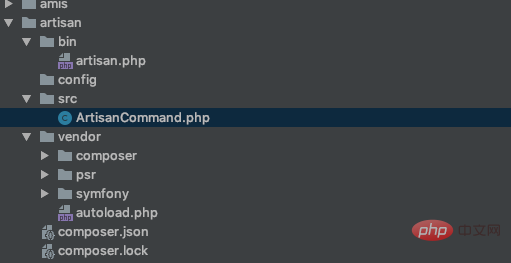如何實現 laravel 的artisan
2020-10-22 18:00:58
laravel 的 artisan 命令列太好用了,換個框架沒有這個功能,於是自己學習實現一些,直接上程式碼
新建目錄
-artisan
--bin
--src
進入artisan composer init
composer require symfony/console
#!/usr/bin/env php
<?php
use Symfony\Component\Console\Application;
use Symfony\Component\Console\Input\InputInterface;
use Symfony\Component\Console\Output\OutputInterface;
require_once __DIR__.'/../vendor/autoload.php';
$app = new Application('artisan','1.1.1');
$app->register('artisan')->setCode(function(InputInterface $input, OutputInterface $output){
$output->writeln('artisan start');
});
$app->run();
exit();
以上是簡單的實現#!/usr/bin/env php
<?php
use Symfony\Component\Console\Application;
use Symfony\Component\Console\Input\InputInterface;
use Symfony\Component\Console\Output\OutputInterface;
use Symfony\Component\Console\Input\InputArgument;
require_once __DIR__ . '/../vendor/autoload.php';
$app = new Application('artisan', '1.1.1');
$app->register('artisan')
->setDescription('myself artisan description')
->setCode(
function (InputInterface $input, OutputInterface $output) {
$name = $input->getArgument('name');
$output->writeln("hello {$name}");
}
)->addArgument('name', InputArgument::REQUIRED, 'please input your name');
$app->run();
exit();
這裡演示瞭如何接收引數#!/usr/bin/env php
<?php
use Symfony\Component\Console\Application;
use Symfony\Component\Console\Input\InputInterface;
use Symfony\Component\Console\Output\OutputInterface;
use Symfony\Component\Console\Input\InputArgument;
use Symfony\Component\Console\Input\InputOption;
require_once __DIR__ . '/../vendor/autoload.php';
$app = new Application('artisan', '1.1.1');
$app->register('artisan')
->setDescription('myself artisan description')
->setCode(
function (InputInterface $input, OutputInterface $output) {
$string = $input->getOption('string');
$name = $input->getArgument('name');
if($string == 'lower'){
$name = strtolower($name);
}
if($string == 'upper'){
$name = strtoupper($name);
}
$output->writeln("hello {$name}");
}
)->addArgument('name', InputArgument::REQUIRED, 'please input your name')
->addOption('string',null,InputOption::VALUE_OPTIONAL,'轉換字串大小','lower')
;
$app->run();
exit();
這裡演示瞭如何給命令列新增選項 ./bin/artisan.php artisan ffff --string='upper' echo FFFF$output->writeln("<info>hello {$name}</info>");
$output->writeln("<error>hello {$name}</error>");
$output->writeln("<comment>hello {$name}</comment>");
$output->writeln("hello {$name}");
可以給它們加上顏色
接下來將命令列拆分為檔案

bin/artisan.php
ArtisanCommand.php
#!/usr/bin/env php
<?php
use Symfony\Component\Console\Application;
use Artisan\ArtisanCommand;
require_once __DIR__ . '/../vendor/autoload.php';
$app = new Application('artisan', '1.1.1');
$app->add(new ArtisanCommand());
$app->run();
exit();
ArtisanCommand.php<?php
namespace Artisan;
use Symfony\Component\Console\Application;
use Symfony\Component\Console\Input\InputInterface;
use Symfony\Component\Console\Output\OutputInterface;
use Symfony\Component\Console\Input\InputArgument;
use Symfony\Component\Console\Input\InputOption;
use Symfony\Component\Console\Command\Command;
class ArtisanCommand extends Command{
public function configure()
{
$this->setName('artisan');
$this->setDescription('myself artisan description')
->addArgument('name', InputArgument::REQUIRED, 'please input your name')
->addOption('string',null,InputOption::VALUE_OPTIONAL,'轉換字串大小','lower');
}
public function execute(InputInterface $input, OutputInterface $output)
{
$string = $input->getOption('string');
$name = $input->getArgument('name');
if($string == 'lower'){
$name = strtolower($name);
}
if($string == 'upper'){
$name = strtoupper($name);
}
$output->writeln("<info>hello {$name}</info>");
$output->writeln("<error>hello {$name}</error>");
$output->writeln("<comment>hello {$name}</comment>");
$output->writeln("hello {$name}");
}
}composer.json
{
"name": "baidu/artisan",
"authors": [
{
"name": "gaobingbing",
"email": "[email protected]"
}
],
"require": {
"symfony/console": "^4.3"
},
"autoload": {
"psr-4": {
"Artisan\\": "src"
}
}
}
至此大功告成,還有其他功能可以去看Symfony檔案以上就是如何實現 laravel 的artisan的詳細內容,更多請關注TW511.COM其它相關文章!